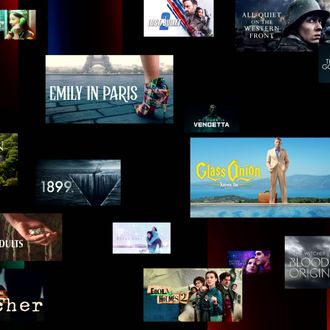
2022 was the year the Streaming Wars broke. The era of huge budgets and endless hubris came to an end as the rent came due all at once. In spring and summer, Netflix, the leader in the space, hemorrhaged users for the first time in ten years, prompting a stock swoon, a swath of layoffs, and a moratorium on the blank checks the company used to dole out to Hollywood needle movers. (Sorry, Bright 2, we hardly knew you.) Plenty of analysts have tried to evaluate exactly what went wrong, and most lay the blame on a combination of a middling slate of original programming and a newfound national stinginess in the face of rising inflation.
Thankfully, Netflix has humbled itself to address at least one of those issues with a new payment plan it put into action this autumn. For a teensy $6.99 per month, anyone can pay for a Netflix subscription … as long as they’re willing to sit through a few commercials during playback.
The plan is called Basic With Ads, and the $6.99 figure is much more aligned with consumer expectations compared with the bloated premium $20 subscription — which I discovered I was still somehow paying for over the course of reporting this story. Swapping for the budget option was a no-brainer. Like many of you, I find Netflix occupies my television screen about once every two weeks since I’m not champing at the bit to experience a litany of identical documentaries focused on minor Twitter story lines from the previous year. (Seriously, how the hell are there two GameStonk documentaries?) In short, Netflix isn’t something I want to spend $240 on each year anymore — its salad days are a distant memory — and the company is finally starting to empathize with my reasoning.
So How Does It Work?
Basic With Ads is functionally identical to Netflix’s $10 Basic plan. You’re capped at a 720p resolution for all of your playback options and are allowed to use only one device on the subscription at a time. (So no, you can’t engineer some sort of weird multi-apartment Bridgerton marathon.) The only sacrifice you need to make to get the $3 discount is to sit through the four minutes of total advertising time that occupied, say, season one, episode two of Stranger Things, which I fired up on my Roku for a test-drive. (Yes, I’m a little late to the Upside Down party.) The first thing I saw on my television was a dewy, luxurious promo for Louis Vuitton, which frankly read as a pointed barb to my newfound money-saving mind-set. Yes, Netflix believes that even those pivoting to Basic With Ads can afford the good life. The commercial breaks are marked by yellow checkpoints on the timeline, like a heavily monetized YouTube video. I fielded offers from Garnier, Buick, and Best Western. None of the ad breaks felt particularly oppressive — in fact, I tend to enjoy a 30-second interval when I’m allowed to check my phone.
Across the board, Netflix appears to be using a light touch with this new monetization stream. I jumped into the eminently watchable Molly’s Game after finishing my adventure in Hawkins, Indiana, and noticed that only five ad breaks were pockmarking the playback. Not bad for a movie with a two-hour, 20-minute runtime. (This is extremely off-topic, but it needs to be said that if Molly’s Game were 100 minutes long, it would have won Best Picture.) More surprising, I found no commercials whatsoever as I examined The Irishman, which led me to assume that the gargantuan scope of the film had broken the algorithm. (I was almost bummed because it would be pretty funny to watch Netflix’s most vaunted original production as if it were broadcasting on TNT.) This didn’t seem to be an exception for all of the company’s house productions: Roma was piped in alongside seven commercial intermissions. If there is a rhyme or reason to this policy, I wasn’t able to deduce it.
How Annoying Are the Commercials?
As for the ad breaks themselves, they all seem to be composed of two or three commercials, of a range between 60 and 90 seconds. There’s no countdown timer allowing you to skip through them — you can’t get out that easily — but you can pause them midstream. (Any muting you do will also need to be manual.) The ads come on at the same volume as whatever you’re already watching, a policy that should be adopted throughout the broadcast industry. I had the same experience on both my laptop and my phone, which again delivered an episode of Big Mouth paired with a hilariously incongruous Louis Vuitton ad.
Is It for You?
Whether you have the patience for all these ad breaks is probably a personal matter. It should be said that I am a budget-streamer adherent. My girlfriend and I have been steadily making our way through all of Mad Men, which is inexplicably streaming free of charge on an anonymous VOD service called Freevee. The dulcet anxiety of Sterling Cooper Draper Pryce is frequently interrupted by hard cuts to commercials, but you would be amazed at how quickly you stop noticing the interruptions.
Will the Basic With Ads plan usher in a Netflix renaissance? Who knows? But the service is gaining subscribers again after an extended fallow winter: 2.4 million users signed up in this past quarter, and many of them are spending less money on the service than ever. That’s the best Netflix can hope for. The future of streaming may not be bright, but it will certainly be cheaper.

